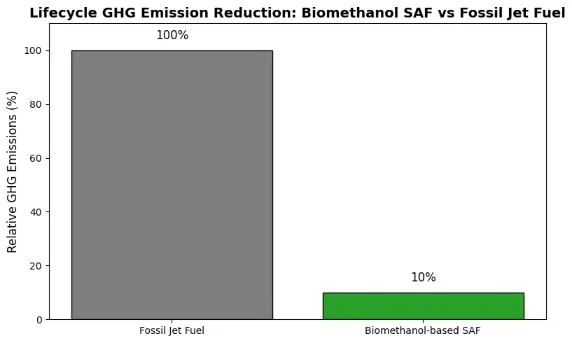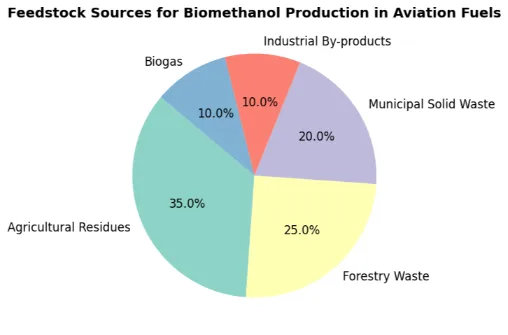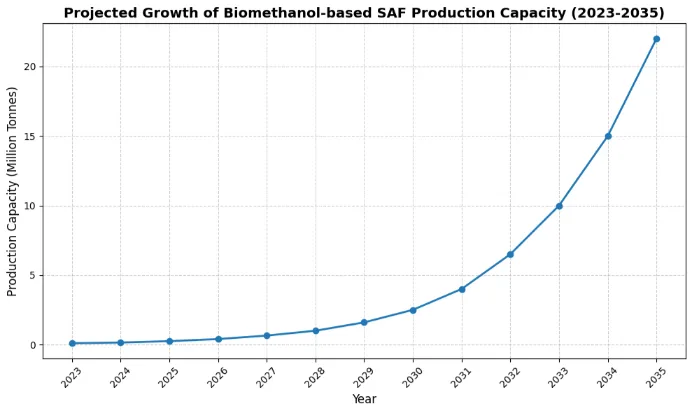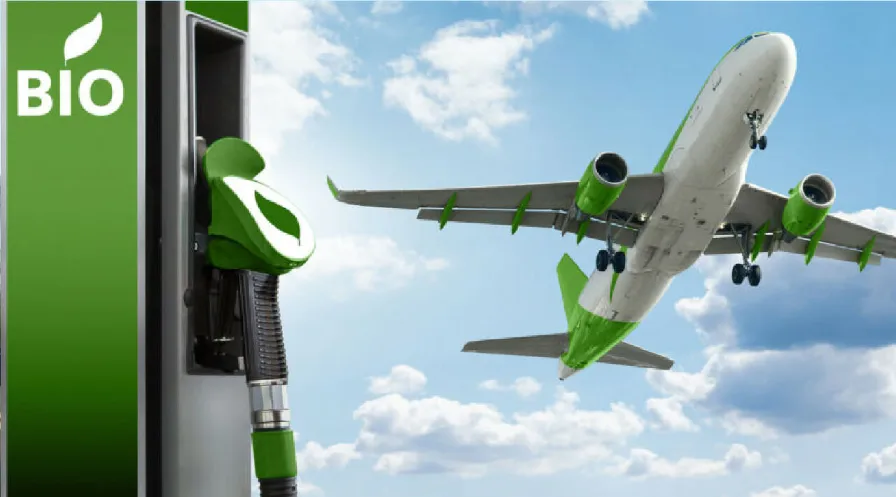
Is Biomethanol the Future of Aviation Fuel? Exploring the Possibilities
The aviation industry is at a critical point. With global air travel rebounding and climate change pressures increasing, the search for sustainable aviation fuels (SAF) is more urgent than ever. Among the promising options, biomethanol—a renewable form of methanol made from biomass—stands out as a potential game changer. But can biomethanol truly fuel the skies of tomorrow? This blog looks at the possibilities, challenges, and future outlook for biomethanol as a sustainable aviation fuel.
Understanding Biomethanol and Its Role in Aviation
Biomethanol is a type of methanol produced from renewable sources like agricultural waste, forestry waste, municipal solid waste, and biogas. Unlike traditional methanol made from fossil fuels, biomethanol has a much lower carbon footprint, often cutting greenhouse gas emissions by up to 90%.
In aviation, biomethanol can act as a feedstock for making sustainable aviation fuels through processes like methanol-to-jet (MTJ) synthesis. This creates drop-in fuels that work with existing aircraft engines and infrastructure. This flexibility is crucial for speeding up adoption without expensive modifications.
Why Sustainable Aviation Fuels Matter
The aviation industry contributes about 2-3% of global CO₂ emissions, and this share is expected to grow significantly in the coming decades. Unlike road transport, aviation has limited options for electrification because of energy density needs, which makes SAF vital for reducing carbon emissions.
Sustainable aviation fuels lower lifecycle emissions by using renewable feedstocks and modern production technologies. They are compatible with current aircraft and airports, allowing for immediate emissions reductions without compromising safety or performance.
Advantages of Biomethanol as Aviation Fuel Feedstock
1. Feedstock Flexibility and Availability
Biomethanol can be made from various biomass sources, including agricultural waste, forestry residues, and municipal solid waste. This variety ensures a steady, scalable supply chain and minimizes competition with food crops while boosting energy security.
2. Lower Carbon Footprint
When produced responsibly, biomethanol can cut greenhouse gas emissions by up to 90% compared to fossil jet fuel. This supports global climate goals and regulatory frameworks like the EU’s ReFuelEU Aviation and the ICAO Carbon Offsetting and Reduction Scheme for International Aviation (CORSIA).
3. Drop-In Fuel Compatibility
Biomethanol-derived synthetic jet fuels can blend with regular jet fuel or be used as 100% SAF in modified engines. This drop-in capability reduces the need for infrastructure changes and helps products enter the market quickly.
4. Supporting Power-to-Liquid (PtL) and E-Fuel Technologies
Producing biomethanol can work alongside renewable hydrogen and captured CO₂ to create e-methanol, an important step for synthetic SAF. This pathway supports a circular carbon economy and boosts fuel sustainability.
5. Economic and Regional Development Benefits
Biomethanol production promotes economic growth in rural areas by creating jobs in biomass collection and processing. It also helps ensure energy independence by using local feedstocks.
Current Developments and Industry Momentum
Several companies and projects are leading the way in biomethanol-based SAF:
- Metafuels (Switzerland) is building an e-SAF production plant that uses green methanol as feedstock. They aim to comply with European sustainability standards and scale production by the mid-2020s.
- Johnson Matthey and SunGas Renewables (USA) plan to create over 500,000 metric tonnes of biomethanol a year, enough to power multiple large aircraft.
- Methanol-to-Jet (MTJ) technology is advancing quickly. Pilot plants are showing that converting biomethanol into high-quality jet fuel is feasible.
Challenges to Overcome
- Production Cost and Scale: Biomethanol and SAF made from biomethanol currently have higher production costs than fossil jet fuel. Increasing production and improving process efficiency are critical for achieving cost parity.
- Feedstock Sustainability and Supply Chain: It is crucial to ensure biomass is sourced sustainably without affecting food security or biodiversity. Developing strong, transparent supply chains is a top priority.
- Regulatory and Certification Hurdles: SAF needs to meet strict aviation fuel standards (e.g., ASTM D7566) and receive regulatory approval. Continued collaboration among industry, regulators, and researchers is required.
- Infrastructure and Market Adoption: While drop-in compatibility is helpful, investments in fuel distribution, airport storage, and blending facilities are necessary to support the widespread use of SAF.
The Future Outlook for Biomethanol in Aviation
The sustainable aviation fuel market is projected to grow at a compound annual growth rate (CAGR) of about 8.5% through 2035. This growth is driven by policy support, corporate commitments, and technological advances. With its flexible feedstock and potential integration with e-fuels, biomethanol is well-positioned to capture a significant portion of this market.
International initiatives like the EU’s ReFuelEU Aviation, the US Renewable Fuel Standard (RFS), and CORSIA are creating demand for SAF. These programs encourage investments in biomethanol production and MTJ technology.
Conclusion: Is Biomethanol the Future of Aviation Fuel?
Biomethanol presents strong advantages as a sustainable aviation fuel feedstock. It is renewable, versatile, and capable of producing drop-in jet fuels that meet industry standards. While there are challenges in scaling production and cutting costs, ongoing technological advancements and supportive policies are driving progress.
As the aviation industry seeks ways to reach net-zero emissions, biomethanol stands out as a promising option for cleaner skies and a sustainable future for flight.
Further Reading on Biomethanol in Aviation


The Quiet Rise of Biomethanol in Clean Aviation – How Waste is Becoming Wings
While we often hear about electric cars and solar power in the clean energy transition, there’s an unsung hero working behind the scenes to decarbonize aviation: biomethanol. This isn’t about pouring liquid fuel made from corn or wood chips directly into jet engines (though that would be fascinating). Instead, innovative companies are perfecting ways to transform this humble molecule into the sustainable aviation fuel (SAF) that will power our future flights.
The magic happens through “Methanol-to-Jet” (MtJ) technology – think of it as alchemy for the 21st century, where companies like Honeywell UOP are turning agricultural waste and captured CO2 into jet fuel through their eFining™ technology. Meanwhile, startups like Switzerland’s Metafuels are building entire “aerobrew” plants (Rotterdam will host their first commercial operation) that can flexibly process different methanol types into SAF.
What makes this particularly exciting? Unlike some biofuels that compete with food crops, biomethanol can be made from municipal trash (thank you, Enerkem for your waste-to-fuel plants) or even recycled industrial emissions. ExxonMobil recently threw its hat in the ring with a proprietary methanol-to-jet process, while engineering firm Topsoe offers MTJet™ technology to anyone serious about making e-fuels.

The aviation industry isn’t just watching – they’re actively preparing. While no commercial flights currently run on pure biomethanol-derived SAF (it’s still early days), airlines are hedging their bets. Virgin Atlantic made headlines with a 100% SAF transatlantic demo flight, while United, Emirates, and JetBlue have all inked major SAF supply deals. Over in Nova Scotia, the Simply Blue Group is developing an entire renewable energy park to produce both SAF and biomethanol from green hydrogen by 2026.
Here’s why this matters for everyday travelers and climate-conscious consumers:
- Your future flight’s fuel might come from yesterday’s landfill waste or industrial byproducts
- Farmers and waste managers could find new revenue streams supplying feedstock
- Airports near methanol facilities (like Rotterdam) may become early SAF hubs
- Ticket prices could stabilize as airlines reduce exposure to fossil fuel markets
The beauty of biomethanol’s role in aviation? It’s not an either/or solution. As Neste’s existing SAF (made from different feedstocks) already powers flights for Alaska Airlines and Ryanair, MtJ technology adds another tool to the toolbox. This diversity matters – there’s no single silver bullet for decarbonizing global aviation, but with every new pathway like methanol-to-jet, the industry gets closer to breaking its oil dependence.

Next time you see a plane overhead, consider this: within a decade, its descendants might be flying on fuel brewed from the very waste we’re learning to value rather than discard. Now that’s what we call turning trash into treasure – literally.
For deeper dives:
- How Honeywell is reinventing fuel production
- Enerkem’s waste transformation magic
- The science behind Topsoe’s MTJet
- Latest SAF flight tests
Explore More on Biomethanol:
Discover unexpected ways biomethanol is already influencing your everyday lifestyle and industries around you.
Compare the advantages of biomethanol and ethanol to understand which fuel will power a greener tomorrow.

